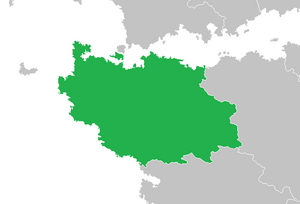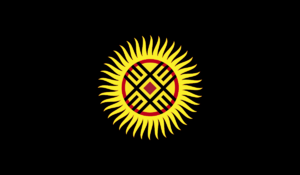Rioni Union
Rioni Union Syara: Sojuz Rioni, Ruvelkan: Rioni Unió | |||||||||||
|---|---|---|---|---|---|---|---|---|---|---|---|
| 1456–1714 | |||||||||||
|
Flag | |||||||||||
 The Union at its greatest extent | |||||||||||
| Capital | Myzova | ||||||||||
| Common languages | Syaran Ruvelkan Hayren Arkoennite | ||||||||||
| Religion | Zobethos, Vilageism | ||||||||||
| Government | Dual Monarchy | ||||||||||
| Historical era | Early Modern Era | ||||||||||
• Established | 1456 | ||||||||||
• Dissolved | 1714 | ||||||||||
| |||||||||||
| Today part of | Syara Ruvelka | ||||||||||
The Rioni Union, (sometimes called the Ruvelkan-Syaran Union, known officially as the Makedonian Khanate to the Arkoennites), was a political union formed between the Prohászka Dynasty of the Principality of Debrecen and the Baligov Dynasty of the Galanian Kingdom at the behest of the Arkoennite Empire for the purpose of administrative simplification of the Empire's vassal states. Over time the Union became a major political, economic, and military power, enough to take advantage of the decline of the Arkoennite Empire and effectively become an autonomous state before fighting a brief war of independence against the Empire between 1709-1711.
After the Arkoennite Empire had conquered the lands of Ruvelka and Syara from the Makedonian Empire in 1305, the task of administering and controlling the vast expanse of north west Siduri fell to the Makedonian throne, operating as a satrapy to Arkoenn. In 1452 the Makedonians rebelled against Arkoennite rule, but failed to gather the support of the other Ruvelkan-Syaran powers and was crushed by the Arkoennites in 154. In response the Arkoennite Great Khan ordered the marriage of Réka Prohászka of the Prohászka Dynasty and Mikhail Baligov of the Baligov Dynasty, unifying the two Houses into a single commonality in 1456. Officially known as the Makedonian Khanate (the Arkoennites labelled virtually all land west of the Kurilla Mountains as Makedonia), the label Rioni Union became more common among Syarans and Ruvelkans owing to the prominence of the Rioni River, which runs from the Kurillas into Galania.
The Union was charged with assisting the Arkoennite Empire in maintaining control over Ruvelka and Syara, mostly in the form of annual tribute, facilitation of trade, and providing soldiers to fight in the Arkoennite armies. Over the course of its duration however Arkoennite influence gradually waned as the Empire fell into internal conflict further west in Arkoenn, occasionally involving the Union. Consolidation of Syara and Ruvelka under a single banner however proved a boon for north-west Siduri; fueled by Galanian agriculture, Ruvelkan mineral resources of gold, iron, and silver, and aided by Syaran ports along the Sundering and Sanguine Seas, the Khanate rapidly developed into an economic powerhouse who's yearly production eclipsed the annual tribute required to be paid to the Arkoennites. By the 17th Century the Rioni Union had become an cornerstone of trade between Eracura and Siduri, as well as a considerable military and political power, with an estimated population of around 50 million by 1650. Cities like Debrecen, Zovahr, Kunhegyes, and Myzova became centers of cultural and literary enrichment.
By the 18th Century the clear decline of the Arkoennites led to increasing moves towards complete independence. In 1709 the Union launched the Rioni War of Independence against the Arkoennite Empire, for which the weakened Arkoennites were in little position to contest and were forced to cede territory east of the Kurillas before a peace treaty was signed in 1711, coinciding largely with the modern day eastern borders of Ruvelka. Hopes that the Union would persevere well into the 18th Century proved fruitless; the removal of the Arkoennites revealed the unstable foundation of the Union, which had done little to bridge the ethno-linguistic divide between Syarans and Ruvelkans. Within four years of the Arkoennite withdrawal the Union collapsed into the Rioni War over disputes of the Zemplen region and taxation of land and resources. The Union was officially dissolved in 1714.
The Rioni Union represented the last time Ruvelka and Syara would be governed under a single banner, resulting in the formation of borders where there had been none for nearly 2,000 years. The political, social, and cultural impact of the Union was immense. Ruvelka would unify repeatedly over the next 200 years, first into the Confederation, then the Imperium, then the Socialist Republic, and finally the Principality, but would face numerous civil wars and uprisings. Syara by comparison would not unify for over 150 years. The collapse of the Union allowed for the re-assertion of independent Syaran Successor States in Galania, Scitaria, Hayreniky, and Makedon. The latter would go on to establish itself as a major military and political power, eventually becoming the driving force behind the formation of the Unification of Syara following its victory over the Ruvelkan Red Army in the Ruvelkan-Makedonian War. Despite its re-emergence, Makedon's Hellenic culture had effectively been ended by the Rioni Union, as Slavization brought upon by Galania's prominent role in the Union effectively altered the linguistic and cultural make up for Syara, ending thousands of years of Hellenic culture, which today persists only in Hellene Gylians.
